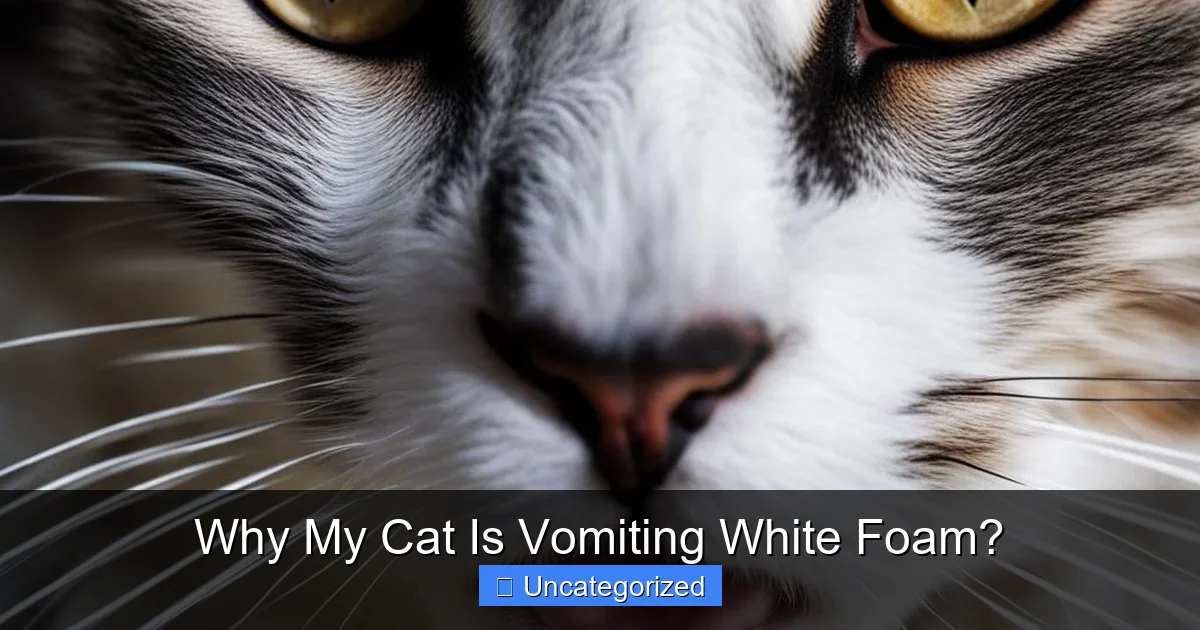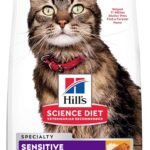Waking up to the unsettling sound of your cat retching, only to find a small puddle of white foam, can be a startling and distressing experience for any pet parent. Your immediate thoughts likely jump to concern: “Is my cat okay? What could be causing this?” While occasional vomiting might be somewhat common in felines, especially if it’s just a hairball, seeing white foam often signals that something deeper might be going on within their delicate digestive system.
This particular type of vomit, characterized by its foamy, sometimes bubbly texture and lack of color or food particles, is typically composed of saliva, stomach acid, and air. It’s a common symptom that can stem from a wide array of underlying issues, ranging from mild dietary indiscretions to more serious health conditions requiring immediate veterinary attention. Understanding why my cat is vomiting white foam is crucial for ensuring their well-being and providing them with the appropriate care.
This comprehensive guide aims to shed light on the various reasons behind this concerning symptom. We’ll explore the common culprits, delve into the signs that warrant an urgent trip to the vet, and provide practical tips to help prevent future episodes. By the end, you’ll have a clearer understanding of what to do if you ever find yourself asking, “why my cat is vomiting white foam?”
Quick Answers to Common Questions
Why is my cat vomiting white foam and what does it mean?
When your cat is vomiting white foam, it usually means their stomach is empty and they’re bringing up stomach acid mixed with saliva and mucus. It often signals irritation or an underlying digestive upset, especially if no food is present.
Should I be concerned if my cat is vomiting white foam?
While an isolated incident of your cat vomiting white foam might not be serious, frequent episodes or if your cat seems otherwise unwell (lethargic, loss of appetite) warrant a call to your veterinarian. Persistent vomiting white foam could indicate a more significant health issue.
What are some common reasons my cat might be vomiting white foam?
Common causes for your cat vomiting white foam include an empty stomach leading to bile reflux, hairballs irritating the digestive tract, or even dietary indiscretions. Less common but more serious reasons can include inflammatory bowel disease, pancreatitis, or kidney disease, so always monitor for other symptoms.
📑 Table of Contents
Understanding White Foam Vomit in Cats
Before diving into specific causes, it’s important to understand what white foam vomit actually is and what it tells us about your cat’s condition. This distinct type of emesis is not just a random occurrence; it has specific characteristics that can provide clues to its origin.
What is White Foam Vomit Composed Of?
- Saliva: During periods of nausea, cats produce excess saliva, which can be regurgitated.
- Stomach Acid: The stomach naturally produces hydrochloric acid for digestion. If the stomach is empty, or if there’s irritation, this acid can be expelled.
- Air: The act of retching and vomiting involves contracting abdominal muscles, which can mix air with stomach contents, creating the characteristic foamy texture.
- Mucus: The stomach lining produces mucus to protect itself. When irritated, excess mucus can be present in vomit.
Unlike vomit containing food, bile (yellow/green liquid), or blood, white foam often indicates an empty stomach or one that is primarily trying to expel irritants rather than digested food. This is often the first clue when you’re trying to figure out why my cat is vomiting white foam.
When to Be Concerned
While an isolated incident of white foam vomit might not always be an emergency, certain factors elevate the level of concern:
- Frequency: Repeated episodes within a short period (e.g., several times a day or over a few days).
- Associated Symptoms: Vomiting accompanied by lethargy, diarrhea, loss of appetite, weight loss, fever, abdominal pain, or changes in behavior.
- Lack of Improvement: If your cat continues to vomit white foam despite a temporary change in diet or routine.
Dietary and Digestive Causes
Often, the answer to “why my cat is vomiting white foam?” lies in their diet or digestive habits. These are some of the most common and generally less severe reasons, but they still warrant attention.

Visual guide about why my cat is vomiting white foam?
Image source: mybritishshorthair.com
Empty Stomach Syndrome (Bilious Vomiting Syndrome)
This is arguably one of the most common reasons a cat vomits white foam. If a cat goes too long between meals, or if their feeding schedule is inconsistent, their stomach can become irritated by a buildup of stomach acid. This irritation often leads to nausea and the expulsion of foamy white or yellowish bile. Providing smaller, more frequent meals can often resolve this issue.
- Practical Tip: Try feeding your cat 3-4 small meals a day instead of 1-2 large ones. A timed feeder can be very helpful for maintaining consistency.
Rapid Eating or Overeating
Some cats eat their food too quickly, gulping down air along with their meal, or they simply eat too much at once. This can lead to regurgitation or vomiting shortly after eating, and sometimes, if the stomach is primarily irritated, it can manifest as white foam.
- Practical Tip: Invest in a slow-feeder bowl or puzzle feeder to encourage slower eating. You can also spread food out on a large, flat surface to slow down consumption.
Hairballs
While classic hairball vomit often includes a tube-like mass of fur, cats can sometimes gag and vomit foamy white liquid prior to or in conjunction with expelling a hairball. The irritation and effort involved in trying to dislodge the hairball can lead to the production of foam. This is a very common reason why my cat is vomiting white foam.
- Practical Tip: Regular grooming (brushing) can significantly reduce the amount of loose fur your cat ingests. Hairball control diets or supplements can also be beneficial.
Dietary Indiscretion or Sudden Food Changes
Eating something they shouldn’t (e.g., houseplant, string, human food scraps) or a sudden, drastic change in their regular cat food can upset a cat’s stomach, leading to irritation and vomiting of white foam. Cats have sensitive digestive systems.
- Practical Tip: Introduce new foods gradually over 7-10 days, mixing increasing amounts of the new food with decreasing amounts of the old food. Keep tempting “human foods” and potential toxins out of reach.
Food Allergies or Sensitivities
Some cats develop allergies or sensitivities to certain ingredients in their food, most commonly proteins like chicken, beef, or dairy. This can cause chronic gastrointestinal upset, manifesting as vomiting (which can be foamy), diarrhea, and skin issues. If you notice repeated episodes and suspect food sensitivity, discussing a limited ingredient or hydrolyzed protein diet with your vet is important.
Gastrointestinal Problems
Beyond simple dietary causes, several more serious gastrointestinal conditions can explain why my cat is vomiting white foam. These often require veterinary diagnosis and treatment.
Gastritis or Inflammatory Bowel Disease (IBD)
Gastritis is an inflammation of the stomach lining, often caused by irritants, infections, or underlying diseases. IBD is a chronic condition characterized by inflammation of the gastrointestinal tract. Both can lead to chronic vomiting, sometimes of white foam, due to persistent irritation and discomfort.
- Symptoms: Chronic vomiting, weight loss, diarrhea, lethargy, loss of appetite.
- Veterinary Action: Diagnosis often involves blood tests, imaging (ultrasound/X-ray), and sometimes biopsies. Treatment may include dietary changes, anti-inflammatory medications, and antibiotics.
Pancreatitis
Inflammation of the pancreas (pancreatitis) can be extremely painful and lead to severe nausea and vomiting. While vomit may sometimes contain bile, it can also present as foamy white liquid if the stomach is empty. This is a serious condition.
- Symptoms: Vomiting, abdominal pain (sometimes evidenced by a hunched posture), lethargy, anorexia, fever.
- Veterinary Action: Urgent veterinary care is required. Diagnosis involves specific blood tests (fPLI), ultrasound, and physical examination. Treatment includes pain management, IV fluids, anti-nausea medication, and nutritional support.
Intestinal Obstruction (Foreign Body)
Cats are notorious for ingesting non-food items like string, small toys, or fabric. If these items get lodged in the digestive tract, they can cause a life-threatening obstruction. Vomiting, often foamy, is a key symptom as the cat tries to expel the blockage or as stomach contents back up. This is an extremely urgent reason why my cat is vomiting white foam.
- Symptoms: Persistent vomiting, lethargy, lack of appetite, abdominal pain, straining to defecate, no stool production.
- Veterinary Action: Immediate veterinary attention is critical. Diagnosis usually involves X-rays, often with contrast, or ultrasound. Surgery is frequently required to remove the obstruction.
Internal Parasites (Worms)
While often associated with diarrhea, a heavy parasitic burden, particularly with roundworms or tapeworms, can cause gastrointestinal irritation and lead to vomiting, including white foam. The worms themselves can irritate the stomach lining or cause blockages in severe cases.
- Symptoms: Vomiting, diarrhea, weight loss despite eating, pot-bellied appearance (especially in kittens), visible worms in stool or vomit.
- Veterinary Action: A fecal sample will be tested to identify the type of parasite. Appropriate deworming medication will be prescribed. Regular deworming is an important preventative measure.
Other Medical Conditions
Sometimes, the reason why my cat is vomiting white foam stems from systemic diseases that affect other organs, causing secondary gastrointestinal upset.
Kidney or Liver Disease
When the kidneys or liver are not functioning properly, toxins can build up in the bloodstream. These toxins can cause severe nausea, leading to vomiting of white foam or other contents. These are serious, chronic conditions that require ongoing management.
- Symptoms: Increased thirst and urination, weight loss, poor coat quality, lethargy, loss of appetite, halitosis (bad breath).
- Veterinary Action: Diagnosis involves blood tests (chemistry panel, complete blood count, urinalysis) and potentially ultrasound. Treatment focuses on managing symptoms, dietary changes, and medications to support organ function.
Hyperthyroidism
Overactive thyroid glands are common in older cats. Excess thyroid hormones speed up metabolism, leading to a variety of symptoms, including increased appetite, weight loss, hyperactivity, and sometimes vomiting (which can be foamy) and diarrhea.
- Symptoms: Weight loss despite a ravenous appetite, hyperactivity, increased thirst, poor coat, vomiting, diarrhea.
- Veterinary Action: Diagnosis involves a simple blood test to measure thyroid hormone levels. Treatment options include medication, radioactive iodine therapy, or surgery.
Diabetes Mellitus (Diabetic Ketoacidosis – DKA)
While diabetes in itself doesn’t always cause vomiting, uncontrolled diabetes can lead to a severe complication called Diabetic Ketoacidosis (DKA). DKA is a life-threatening condition where the body starts breaking down fat too quickly, producing toxic ketones that cause severe nausea and vomiting, often of white foam, along with extreme lethargy and dehydration.
- Symptoms: Increased thirst and urination, weight loss despite good appetite, lethargy, vomiting, sweet-smelling breath (during DKA).
- Veterinary Action: Immediate veterinary attention is required for DKA. Diagnosis involves blood and urine tests. Treatment includes insulin therapy, fluid therapy, and electrolyte management.
Toxins and Poisons
Ingestion of toxic substances is a veterinary emergency. Many household products, plants, medications, and chemicals can be poisonous to cats, causing rapid onset of vomiting. If the cat vomits before the toxin has been digested, it may appear as white foam, often with other symptoms like tremors, disorientation, or collapse. If you suspect your cat has ingested a toxin, and this is why my cat is vomiting white foam, seek immediate veterinary care.
- Common Toxins: Lilies, antifreeze, rodenticides, certain human medications (e.g., ibuprofen, acetaminophen), cleaning products.
- Veterinary Action: Contact your vet or an animal poison control center immediately. Treatment depends on the type of toxin and may involve induced vomiting (only under vet supervision), activated charcoal, IV fluids, and supportive care.
When to Seek Veterinary Care and What to Expect
Given the wide range of potential causes, knowing when to call the vet is paramount. While some causes are mild, others can be life-threatening.
Red Flag Symptoms Requiring Immediate Vet Attention
- Repeated vomiting (more than once or twice in 24 hours).
- Vomiting accompanied by lethargy, weakness, or collapse.
- Vomiting with diarrhea, especially if bloody or very watery.
- Loss of appetite for more than 12-24 hours.
- Signs of pain (hiding, vocalizing, hunching).
- Swollen or painful abdomen.
- Suspected ingestion of a foreign body or toxin.
- Fever or unusually low body temperature.
If you observe any of these symptoms alongside your cat vomiting white foam, do not delay in contacting your veterinarian.
What to Tell Your Veterinarian
When you call or visit the vet, be prepared to provide as much information as possible. This helps them narrow down the possible reasons why my cat is vomiting white foam.
- Frequency and Timing: How often is your cat vomiting? Does it happen at a specific time (e.g., after eating, in the morning)?
- Appearance of Vomit: Describe the foam – is it thick, bubbly, white, clear? Are there any other contents (blood, bile, food particles)?
- Diet: What does your cat eat? Any recent changes in food or treats? Has your cat eaten anything unusual?
- Other Symptoms: Any changes in appetite, thirst, urination, bowel movements, energy levels, or behavior?
- Medications/Supplements: Is your cat currently on any medications or supplements?
- Environmental Changes: Any new plants, household cleaners, or potential toxins in the home?
- Medical History: Any pre-existing medical conditions or recent illnesses?
Diagnostic Procedures and Treatment
Your vet will perform a thorough physical examination. Depending on their findings and your history, they may recommend further diagnostics:
- Blood Work: Complete Blood Count (CBC) and Chemistry Panel to check for infection, inflammation, organ function (kidney, liver, pancreas), and hydration status.
- Urinalysis: To assess kidney function and rule out urinary tract infections or diabetes.
- Fecal Exam: To check for intestinal parasites.
- X-rays (Radiographs): To look for foreign bodies, obstructions, or abnormalities in organ size and shape.
- Ultrasound: Provides a more detailed view of internal organs, especially the GI tract, pancreas, liver, and kidneys.
- Endoscopy/Biopsy: For chronic cases, to obtain tissue samples for definitive diagnosis of conditions like IBD.
Treatment will depend entirely on the underlying cause. It could range from simple dietary adjustments and anti-nausea medication to more complex treatments like IV fluids, antibiotics, anti-inflammatory drugs, or even surgery in cases of obstruction or severe disease. The ultimate goal is to address why my cat is vomiting white foam and resolve the root cause.
Preventing Future Episodes
While you can’t prevent every instance of your cat vomiting white foam, there are several proactive steps you can take to minimize the risk, especially for the more common causes.
Regular and Consistent Feeding Schedule
To prevent empty stomach syndrome, feed your cat smaller, more frequent meals (e.g., 3-4 times a day). This keeps stomach acid diluted and prevents it from building up and causing irritation.
Slow Feeder Bowls and Portion Control
If your cat eats too quickly, a slow feeder or puzzle feeder can help. Ensure you are feeding the appropriate amount of food for your cat’s age, weight, and activity level to prevent overeating.
Effective Hairball Management
Regular brushing, especially for long-haired breeds, is crucial. Consider hairball control diets, treats, or supplements that help ingested fur pass through the digestive system more easily.
Safe Environment and Diet
Keep potential toxins (human medications, cleaning supplies, toxic plants, strings, small objects) out of your cat’s reach. Avoid feeding human food scraps, and make any changes to your cat’s diet gradually.
Regular Veterinary Check-ups
Preventative care is key. Regular vet visits allow for early detection of underlying health issues like kidney disease, hyperthyroidism, or dental problems that could lead to vomiting. Routine deworming and parasite prevention are also vital.
Summary of Common Causes and Urgency
To help you quickly assess the situation when asking, “why my cat is vomiting white foam?”, here’s a brief overview of common causes and their typical urgency levels:
| Cause | Description | Urgency Level | Common Associated Signs |
|---|---|---|---|
| Empty Stomach Syndrome | Stomach acid buildup from long periods between meals. | Low-Medium | Vomiting in the morning, resolves with consistent feeding. |
| Hairball | Irritation from ingested fur trying to pass. | Low-Medium | Gagging, coughing, hair in vomit or stool. |
| Dietary Indiscretion | Eating unsuitable food or sudden diet change. | Medium | Acute onset of vomiting, possibly diarrhea, often self-limiting. |
| Gastritis / IBD | Inflammation of the stomach/intestines. | Medium-High | Chronic vomiting, weight loss, diarrhea, lethargy. |
| Intestinal Obstruction | Foreign body blocking the digestive tract. | HIGH (Emergency) | Persistent vomiting, no appetite, abdominal pain, lethargy, no stool. |
| Pancreatitis | Inflammation of the pancreas. | HIGH (Emergency) | Severe vomiting, abdominal pain, lethargy, anorexia. |
| Kidney/Liver Disease | Organ dysfunction leading to toxin buildup. | High (Chronic) | Increased thirst/urination, weight loss, lethargy, poor appetite. |
| Hyperthyroidism | Overactive thyroid glands. | High (Chronic) | Weight loss despite good appetite, hyperactivity, increased thirst, vomiting. |
| Toxin Ingestion | Poisonous substance consumed. | CRITICAL (Immediate Emergency) | Sudden vomiting, tremors, collapse, disorientation, drooling. |
Conclusion
Observing your cat vomiting white foam is never pleasant, and it’s a symptom that should always be taken seriously. While some reasons why my cat is vomiting white foam might be benign and easily remedied with dietary adjustments, others can point to severe, life-threatening conditions requiring urgent veterinary intervention. The key is careful observation of your cat’s overall behavior, appetite, and any accompanying symptoms.
Never hesitate to contact your veterinarian if you are concerned. They are the best resource to accurately diagnose the underlying cause and recommend the most appropriate course of treatment, ensuring your feline companion receives the care they need to return to their happy, healthy self. Early intervention can make a significant difference in the outcome for many of the conditions discussed, reinforcing the importance of being proactive when faced with this unsettling symptom.
Frequently Asked Questions
What does it mean if my cat is vomiting white foam?
Vomiting white foam from your cat usually indicates an irritated or empty stomach. This foamy substance is typically a mixture of stomach acids, saliva, and mucus, suggesting there isn’t any undigested food present. It’s a common sign of gastric upset.
What are the common reasons why my cat is vomiting white foam?
Common reasons include an empty stomach, leading to bile reflux, or an inflamed stomach lining (gastritis). Other causes can be hairballs that are difficult to pass, dietary indiscretion, or sudden changes in food. It can also signal more serious underlying issues like pancreatitis or kidney disease.
When should I be concerned about my cat vomiting white foam and seek veterinary help?
You should be concerned if your cat is vomiting white foam frequently, appears lethargic, or stops eating and drinking. Look out for additional symptoms like diarrhea, blood in the vomit, or signs of pain. Persistent vomiting over 24 hours warrants immediate veterinary attention.
Can hairballs cause my cat to vomit white foam?
Yes, hairballs are a very common cause for a cat to vomit white foam. As your cat grooms, they ingest fur, which can accumulate in their stomach and irritate the lining if not passed. This irritation often results in the expulsion of white foam as the stomach attempts to clear the obstruction.
What immediate steps should I take if my cat is vomiting white foam?
Initially, withhold food for 6-12 hours to allow their stomach to rest, but ensure constant access to fresh water. After this period, offer small, frequent amounts of a bland diet like plain boiled chicken or white fish. Monitor their condition closely, and contact your veterinarian if vomiting continues or other symptoms develop.










